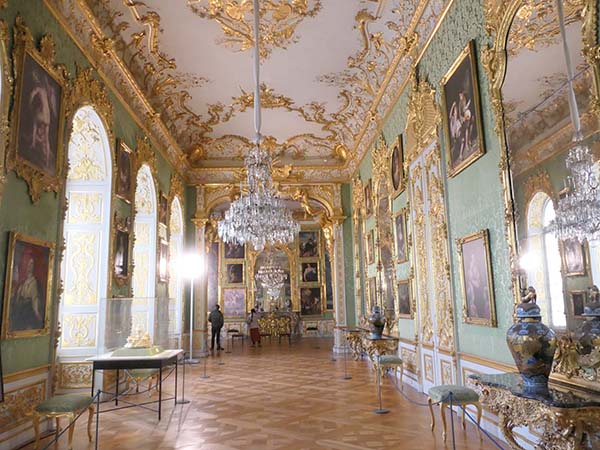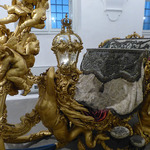While in Munich for work in February, I spent a little bit of time exploring on the weekends. One of the places that I visited was Munich Residenz. The Munich Residenz (Munich Residence) was a residence and government office of the Bavarian dukes, electors and kings from 1508 to 1918. The building, which was originally a castle, was transformed in the late-1300s into a palace with courtyards, fountains, and a grotto over the decades. The palace was the principle seat of government from the House of Wittelsbach; it opened to the public in 1920. There are over 130 rooms on display with Renaissance, Rococo, Early Baroque, and Neoclassic styles. The building suffered great damage after World War II, so some of the artwork had to be reconstructed.

The building is located in the northern part of the city centre, and it's quite a large complex with interior courtyard.


The northern side of the palace contains gardens.

A statue of Poseidan (Neptune), the god of the oceans, greets visitors toward the entrance. After entering, I paid in the gift shop and then started the self-guided tour.

One of the most beautiful rooms was the Ancestral Gallery of the House of Wittelsbach. The room is considered to be one of the masterpieces of South German Rococo. Emperor Ludwig of Bavaria, Charlemagne, and the first duke have portraits here. The room has gilded decorations and beautiful ceiling paintings.


The Grotto Courtyard was created under Wilhelm V, and it was built in the late 1500s and inspired by Italian Renaissance gardens. It shows the gods of Olympus and Ovid's Metamorphoses and is created from shells and crystals.




The next room, which is off the grotto, is a long room called the Antiquarium. It was built in the mid-1500s to show off antiquities. It is the largest Renaissance hall north of the Alps. A royal table would have sat in front of the fireplace at the head of the hall when the Duke wanted to dine publicly. A small collection of sculptures and fine china with blue and yellow colours can be seen here. The long room is decorated beautifully with paintings decorating the rows of arches and ceiling.



On the other side of the hallway is a sculpture called Venus Monacensis, known as Munich's goddess. Venus is attempting to cover herself with drapery in this puece by Antonio Canova, whose work was very popular in Europe.

The Black Hall was up next, named such due to the black door frames.

The Chapel, known as the former Cecilia Chapel, was destroyed in the second World War. It dated from the late-1600s, and it was inspired by oval Italian churches. There were some fine examples of china and trinkets around, such as a tea set and other items.


After this room, I came upon a series of lavishly-decorated rooms - such as antechambers and dining rooms. These form the Electoral apartments, which are in Rococo style. The elected would live in the apartments here.







The Court Church of All Saints was commissioned and built by King Ludwig I in the mid-1800s. It suffered much damage in the second World War and was not open until 2003.

The next set of rooms on display are the Court Garden and Charlotte Chambers. Connecting corridors were created with apartments leading off.


No palace is complete without a music room.

A model of the palace could also be viewed in one of the rooms here.

The Ornate Rooms were lavishly decorated in the mid-1700s by Emperor Karl VII, and they represent ceremonial events with splendour and status. The Conference Chamber is designed in a similar style, and this room was for private audiences.


The Green Gallery is a picture gallery built in the mid-1700s after the Ornate Rooms. The ceiling details were destroyed in the war.




The State Bedroom was not a private bedroom by the elector. It was used for representative purposes.

The State Bedroom leads off to two lavish rooms - the Cabinet of Mirrors and the Cabinet of Miniatures.





Cloakroom.

Red Room and Heart Cabinet; the bedroom was destroyed in 1944 but was a very private room.

Queen Mother's Staircase


Queen's Throne Room


The King's Reception Room has influences of Pompeii wall paintings.






King's Throne Room

Wedding Hall - depicts scenes from the Saxons and Danes disputes. There are a few of these rooms called the Nibelungen Halls, which contain the frescoes depicting the various scenes of the medieval poem "Nibelungenlied", an epic German heroes tale.




The Nibelungen Halls were beautiful and depicted several scenes from the poem. The Hall of Vengeance depicts the last part in the "Nibelungenlied" with the battle between Burgundians and the Huns and the downfall of the Burgundians.

Several additional rooms contained various displays of items, such as pottery and ceramics. I did not linger in this area too long.


I enjoyed my visit to Residenz in Munich. There were many rooms to explore, and many of the rooms were decorated beautifully. For those interested in other places to visit in Munich, check out Nymphenburg Palace.



Leave a comment